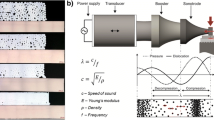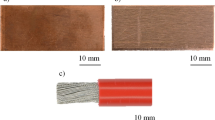Abstract
Ultrasonic wire welding is considered a method of choice for creating reliable interconnects in electronics industry including aerospace, batteries and electric vehicles. In this paper, ultrasonic welding tests between EVR252 copper wire and substrate are carried out. Novel pattern morphologies are machined on substrates to explore its influence on mechanical properties of welded joint. Patterns are divided into three different categories e.g., original surface, vertical and horizontal shapes. Cracks, microstructure strength and tensile properties of welded joint are studied and its joining mechanism is analysed. Compared with the reference substrate (S1), the welded joint performance of the longitudinal patterns (S2, S3, S4) has been improved, among which the longitudinal pattern (S4) has the most significant improvement (+ 15%). Likewise, the performance of transverse pattern (S5) welded joints is relatively poor (− 16%). The microstructural analysis using SEM has revealed predominant joint strength on Cu wire surface while maintaining rock-like and compact properties of S4 substrate. Upper side of wire-harness compactness is frequently observed due to vertical direction of patterns on substrate and also increases the strength of welded joint. Values of failure load, failure displacement and failure energy absorption were increased by 7.9%, 72% and 35% for S2, 6.1%, 75% and 42% for S3 and 15%, 87% and 113% for S4 compared to S1. Failure modes of welded joints are mainly characterized into: 1-poor ductility or rupture (no deformation) failure in vertical 3-line pattern joints 2-cylindrical deep holes failure in vertical 3-line zigzag pattern joints and 3-bulging effect failure in horizontal 3-line zigzag pattern joints. Point and line scans EDS measurement were performed to investigate weaker and stable trends of different locations in welded joints. In S4 substrate, 17.9% carbon content at the position of welded joint was investigated, leading to content of less oxides and fraction impurities. However, S1 weld zone contains 38.7% carbon content which can weaken welded joint and reduce durability.
Graphical Abstract














Similar content being viewed by others
Data availability
The datasets used and/or analyzed during the current study are available from the corresponding author upon reasonable request.
References
E. Riedel, M. Liepe, S. Scharf, Simulation of ultrasonic induced cavitation and acoustic streaming in liquid and solidifying aluminum. Metals (Basel) 10, 476 (2020). https://doi.org/10.3390/met10040476
M.P. Matheny, K.F. Graff, Ultrasonic Welding of Metals (Elsevier Ltd, Amsterdam, 2015)
A. Gester, G. Wagner, P. Pöthig et al., Analysis of the oscillation behavior during ultrasonic welding of EN AW-1070 wire strands and EN CW004A terminals. Weld. World 66, 567–576 (2022). https://doi.org/10.1007/s40194-021-01222-z
H. Huang, J. Chen, Y.C. Lim et al., Heat generation and deformation in ultrasonic welding of magnesium alloy AZ31. J. Mater. Process. Technol. 272, 125–136 (2019). https://doi.org/10.1016/j.jmatprotec.2019.05.016
A. Levy, S. Le Corre, I. Fernandez Villegas, Modeling of the heating phenomena in ultrasonic welding of thermoplastic composites with flat energy directors. J. Mater. Process. Technol. 214, 1361–1371 (2014). https://doi.org/10.1016/j.jmatprotec.2014.02.009
D. Zhao, K. Zhao, D. Ren, X. Guo, Ultrasonic welding of magnesium-titanium dissimilar metals: a study on influences of welding parameters on mechanical property by experimentation and artificial neural network. J. Manuf. Sci. Eng. 139, 031019 (2017). https://doi.org/10.1115/1.4035539
F. Rubino, H. Parmar, V. Esperto, P. Carlone, Ultrasonic welding of magnesium alloys: a review. Mater. Manuf. Process. 35, 1051–1068 (2020). https://doi.org/10.1080/10426914.2020.1758330
C. Liu, Y. Gong, Y. Wang et al., Preparation and characterization of wear resistant TiO layer on Ti alloy. Surf. Coat. Technol. 470, 129833 (2023). https://doi.org/10.1016/j.surfcoat.2023.129833
S.S. Ao, M.P. Cheng, W. Zhang et al., Microstructure and mechanical properties of dissimilar NiTi and 304 stainless steel joints produced by ultrasonic welding. Ultrasonics 121, 106684 (2022). https://doi.org/10.1016/j.ultras.2022.106684
S.K. Bhudolia, G. Gohel, K.F. Leong, Advances in ultrasonic welding of thermoplastic composites: a review. Materials 13, 1284 (2020). https://doi.org/10.3390/ma13061284
J. Liu, B. Cao, J. Yang, Effects of vibration amplitude on microstructure evolution and mechanical strength of ultrasonic spot welded Cu/Al joints. Metals (Basel) 7, 471 (2017). https://doi.org/10.3390/met7110471
D. Zhao, C. Jiang, K. Zhao, Ultrasonic welding of AZ31B magnesium alloy and pure copper: microstructure, mechanical properties and finite element analysis. J. Mater. Res. Technol. 23, 1273–1284 (2023). https://doi.org/10.1016/j.jmrt.2023.01.095
D. Zhao, W. Wang, D. Ren, K. Zhao, Research on ultrasonic welding of copper wire harness and aluminum alloy: based on experimental method and GA-ANN model. J. Mater. Res. Technol. 22, 3180–3191 (2023). https://doi.org/10.1016/j.jmrt.2022.12.155
Z. Du, L. Duan, L. Jing et al., Numerical simulation and parametric study on self-piercing riveting process of aluminium–steel hybrid sheets. Thin-Walled Struct. 164, 107872 (2021). https://doi.org/10.1016/j.tws.2021.107872
Z. Lun, W. Shicheng, L. Jiguang et al., Performance enhancement of clinched joints with ultrasonic welding for similar and dissimilar sheet metals. Weld. World 12, 2715–2729 (2023). https://doi.org/10.1007/s40194-023-01589-1
H. Li, B. Cao, J.W. Yang, J. Liu, Modeling of resistance heat assisted ultrasonic welding of Cu–Al joint. J. Mater. Process. Technol. 256, 121–130 (2018). https://doi.org/10.1016/j.jmatprotec.2018.02.008
J. Saleem, A. Majid, K. Bertilsson et al., Nugget formation during resistance spot welding using finite element model. Int. Sch. Sci. Res. Innov. 6, 707–712 (2012)
P. Pöthig, M. Grätzel, J.P. Bergmann, Influence of different surface conditions on mechanical properties during ultrasonic welding of aluminum wire strands and copper terminals. Weld. World 67, 1427–1436 (2023). https://doi.org/10.1007/s40194-023-01490-x
D. Zhao, D. Ren, K. Zhao et al., Ultrasonic welding of magnesium-titanium dissimilar metals: a study on thermo-mechanical analyses of welding process by experimentation and finite element method. Chin. J. Mech. Eng. (English Ed) 32, 97 (2019). https://doi.org/10.1186/s10033-019-0409-8
J. Tsujino, S. Ihara, Y. Harada et al., Characteristics of coated copper wire specimens using high frequency ultrasonic complex vibration welding equipments. Ultrasonics 42, 121–124 (2004). https://doi.org/10.1016/j.ultras.2004.01.051
X.M. Cheng, K. Yang, J. Wang et al., Ultrasonic welding of Cu to Al cables bonding: evolution of microstructure and mechanical properties. Mater. Charact. 200, 112905 (2023). https://doi.org/10.1016/j.matchar.2023.112905
Z. Liu, S. Ji, X. Meng, Joining of magnesium and aluminum alloys via ultrasonic assisted friction stir welding at low temperature. Int. J. Adv. Manuf. Technol. 97, 4127–4136 (2018). https://doi.org/10.1007/s00170-018-2255-8
J. Li, J. Zillner, F. Balle, In-depth evaluation of ultrasonically welded Al/Cu joint: plastic deformation, microstructural evolution, and correlation with mechanical properties. Materials 16, 3033 (2023). https://doi.org/10.3390/ma16083033
H. Ji, J. Wang, M. Li, Evolution of the bulk microstructure in 1100 aluminum builds fabricated by ultrasonic metal welding. J. Mater. Process. Technol. 214, 175–182 (2014). https://doi.org/10.1016/j.jmatprotec.2013.09.005
S.H. Kang, H.K. Kim, Fatigue strength evaluation of self-piercing riveted Al-5052 joints under different specimen configurations. Int. J. Fatigue 80, 58–68 (2015). https://doi.org/10.1016/j.ijfatigue.2015.05.003
S. Lu, D. Wu, M. Yan, R. Chen, Achieving high-strength and toughness in a Mg–Gd–Y alloy using multidirectional impact forging. Materials (Basel) 15, 1508 (2022). https://doi.org/10.3390/ma15041508
S. Kumar, C.S. Wu, G.K. Padhy, W. Ding, Application of ultrasonic vibrations in welding and metal processing: a status review. J. Manuf. Process. 26, 295–322 (2017). https://doi.org/10.1016/j.jmapro.2017.02.027
K.J. Pradeep, K. Prakasan, Acoustic horn design for joining metallic wire with flat metallic sheet by ultrasonic vibrations. J. Vibroeng. 20, 2758–2770 (2018). https://doi.org/10.21595/jve.2018.19648
M. Schramkó, Z. Nyikes, H. Jaber, T.A. Kovács, Dissimilar joining by ultrasonic welding. J. Hunan Univ. Nat. Sci. 49, 185–191 (2022). https://doi.org/10.55463/issn.1674-2974.49.3.20
R.P. Singh, S. Dubey, A. Singh, S. Kumar, A review paper on friction stir welding process. Mater. Today Proc. 38, 6–11 (2020). https://doi.org/10.1016/j.matpr.2020.05.208
P. Pöthig, M. Grätzel, J.P. Bergmann, Influence of different surface conditions on mechanical properties during ultrasonic welding of aluminum wire strands and copper terminals. Weld. World 67, 1427–1436 (2023). https://doi.org/10.1007/s40194-023-01490-x
A. Ben Khalifa, S. Braiek, A. Fradj, M. Trigui, Experimental investigation of joints strength obtained by ultrasonic welding and soldering under pure T-peel tests using DIC. Weld. World 67, 495–511 (2023). https://doi.org/10.1007/s40194-022-01437-8
H. Lu, F. Ye, Y. Wang, Orthogonal experiments and bonding analysis of ultrasonic welded multi-strand single core copper cables. J. Manuf. Process. 78, 1–10 (2022). https://doi.org/10.1016/j.jmapro.2022.04.007
F. Ye, H. Lu, H. Qi, Joints formation and bonding mechanism of ultrasonic welded multi-strand single core copper cables with copper terminals. Mater. Lett. 327, 133015 (2022). https://doi.org/10.1016/j.matlet.2022.133015
M.P. Satpathy, S.K. Sahoo, Microstructural and mechanical performance of ultrasonic spot welded Al-Cu joints for various surface conditions. J. Manuf. Process. 22, 108–114 (2016). https://doi.org/10.1016/j.jmapro.2016.03.002
C.B.G. Brito, J. Teuwen, C.A. Dransfeld, I.F. Villegas, The effects of misaligned adherends on static ultrasonic welding of thermoplastic composites. Compos. Part A Appl. Sci. Manuf. 155, 106810 (2022). https://doi.org/10.1016/j.compositesa.2022.106810
Z.M. Su, P.C. Lin, W.J. Lai, J. Pan, Fatigue analyses of self-piercing rivets and clinch joints in lap-shear specimens of aluminum sheets. Int. J. Fatigue 72, 53–65 (2015). https://doi.org/10.1016/j.ijfatigue.2014.09.022
L. Zhao, X. He, B. Xing et al., Fracture mechanism of titanium sheet self-piercing riveted joints. Thin-Walled Struct. 144, 106353 (2019). https://doi.org/10.1016/j.tws.2019.106353
Acknowledgements
This research is supported by National Natural Science Foundation of China (Grant No. 12104324); Postdoctoral Science Foundation of China (No. 2021M703392); Scientific Research Startup Fund for Shenzhen High-Caliber Personnel of SZPT (No.6022310046K); Postdoctoral Startup Fund of Shenzhen Polytechnic University (No. 6021330001K and No. 6022331008K).
Author information
Authors and Affiliations
Contributions
ZA and ZL, methodology, validation, investigation, formal analysis; ZA and FT, writing-original draft, writing-review and editing, visualization; ZA and FT, investigation, and formal analysis; ZA and ZL: conceptualization, methodology, validation, resources, visualization; ZL: supervision, project administration, funding acquisition; ZA, and MSI: writing-review and editing. All authors read and approved the final draft of the manuscript.
Corresponding author
Ethics declarations
Conflict of interest
The authors declare that they have no known competing financial interests or personal relationships that could have appeared to influence the work reported in this paper.
Ethical approval
Not applicable.
Approval for animal experiments
Not applicable.
Consent to participate
Not applicable.
Consent for publication
Not applicable.
Additional information
Publisher's Note
Springer Nature remains neutral with regard to jurisdictional claims in published maps and institutional affiliations.
Rights and permissions
Springer Nature or its licensor (e.g. a society or other partner) holds exclusive rights to this article under a publishing agreement with the author(s) or other rightsholder(s); author self-archiving of the accepted manuscript version of this article is solely governed by the terms of such publishing agreement and applicable law.
About this article
Cite this article
Abbas, Z., Teng, F., Zhao, L. et al. Influence of Patterns on Mechanical Properties of Ultrasonically Welded Joints in Copper Substrate and Wire. Met. Mater. Int. (2024). https://doi.org/10.1007/s12540-024-01646-4
Received:
Accepted:
Published:
DOI: https://doi.org/10.1007/s12540-024-01646-4




